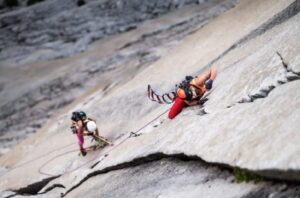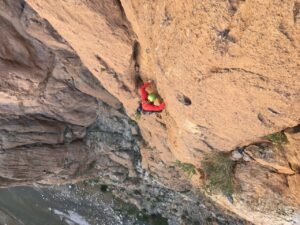For travelers, Cuba offers world-famous musicians, unique cuisine, and a complex history. But it has also become a hidden gem of North American climbing that few outside the sport’s innermost circles know about.
Two-and-a-half hours from Havana lies a sport climbing mecca called El Techo del Mundo — The Roof of the World. A few quick glances at the beautiful overhanging limestone formations of this crag will have most rock hounds itching to chalk up.
View this post on Instagram
There’s also another developed crag near Holguin, a colonial town located on the far side of the island from Havana. And who wouldn’t want to climb an aging colonial battlement, as seen in one of the many incredible photos on the website of local guide Tito Jorge?

A pillar near Jibacoa Beach, an hour from Havana. Photo: Tito Jorge
Cuba comes with challenges, of course. It’s not as easy to reach these crags as it is to fly to Monterrey, Mexico for a couple of days at El Potrero Chico.
But as sport climbing has rapidly grown in popularity, it has become harder and harder to find tranquil, unspoiled destinations. For those itching for something different, Cuba offers the next big thing, says Jorge.
“What makes Cuba special from other parts of the world in terms of climbing is the climate and the type of climbing,” Jorge said in an email. “The tourists who visit us every year say that the quality of the rock is spectacular. The weather during the climbing season is perfect. [And no matter where you go], you can find just two or three people climbing. You will not have to wait to climb a route.”

Tito Jorge bolts a new route at El Techo del Mundo in Cuba. Photo: Tito Jorge
El Techo del Mundo
For those trying out Cuban climbing for the first time, El Techo del Mundo is the obvious place to start.
Most of the routes here have been established by Jorge and his friends. Located near Viñales, a town about two hours from the capital, it’s a clean, tranquil climbing area surrounded by verdant fauna.
However, it’s also not an area for beginners. The crag’s gigantic ceilings tend to start at grades too hard for the inexperienced. As a rule, routes require technical, powerful climbing amid the stalactites hanging down from the steep overhangs.
“The Roof of the World is surely the best sport climbing area in all of Cuba for lovers of climbing on roofs and hard grades,” Jorge said. “The place is intimidating because of the level of inclination of the wall. Visiting climbers are surprised and are forced to do their best even to warm up. Here, 7a is the lowest grade.”

A climber on one of the many hard routes at El Techo del Mundo. Photo: Tito Jorge
However, there’s more to climb near Viñales than just El Techo del Mundo. There’s also La Cueva Cabeza de la Vaca, a small crag surrounded by waterfalls and stalactites, and La Costanera, another limestone wall for hot days.
As for Holguin, climbers will need a much longer trip to reach Cuba’s second major crag. Yet the area offers more than 50 established sport routes.
In both crags, Jorge and other dedicated Cuban climbers continue to update route hardware to ensure safe climbing for potential visitors.

Two more crags close to Viñales: Guajiro Wall on the left and Milenio Wall on the right. Photos: Tito Jorge
How to climb in Cuba
While the photos can inspire impulsive ticket buying, potential travelers to Cuba need to do their research ahead of time.
Between the United States’ ongoing embargo of Cuba and the nation’s own repressive government, it’s not exactly a cakewalk for travelers.
For starters, accessing your money while in Cuba lies somewhere between difficult and impossible, depending on your nation of origin. That means bringing plenty of cash with you before arriving at the Havana airport.
The best way to visit El Techo del Mundo is to spend a few days in Viñales. Though not too far from Havana, a taxi still costs about $100 one way.

Tito Jorge tries out a new project near Viñales. Photo: Tito Jorge
Once in Viñales, climbers will have an easier time, with access to cheap hotels, and taxis that cost just $8 to reach the crag. It’s a good idea to bring equipment with you, as a guided day of climbing with provided equipment can cost $40-50, according to Jorge.
At a minimum, climbers should consider at least a day of orientation with a guide like Jorge, who is fluent in English and Spanish. In fact, that’s a good rule of thumb for any climber visiting an area in its embryonic stages. Variables like rock quality and hardware integrity (meaning especially: the rate at which the specific climate degrades bolts, making them unsafe) can fluctuate more widely in the early going.
Reach Jorge at jorgepimentelmorales@gmail.com.
“Rock is rock, it’s true, but climbing in Cuba isn’t like climbing in any other place,” author Jonny Miles wrote. “Climbing in Cuba is as much about Cuba as it is about climbing.”
Want to learn more? Check out this helpful website about Cuban climbing.






